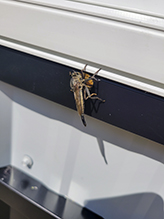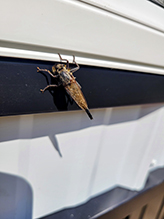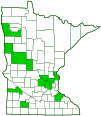Milbert’s proctacanthus
(Proctacanthus milbertii)
Conservation • Description • Habitat • Ecology • Distribution • Taxonomy
Conservation Status |
|
|||||||
| IUCN Red List | not listed |
|||||||
| NatureServe | NNR - Unranked |
|||||||
| Minnesota | not listed |
|||||||
Description |
||
Milbert’s proctacanthus is a common, large, robust, late summer, robber fly. It occurs across the United States and southern Canada. Adults are active from July to early September. Adults are 1⅛″ to 1 9⁄16″ (28 to 40 mm) in length, the females a little larger than the males. The lower three-fourths of the face is swollen. The patch of hairs above the mouth (mystax) is yellow and the beard is pale yellow. The antennae have 3 segments. The third segment is elongated and has a long bristle (arista) at the end. The arista is bare, not feather-like (plumose). The thorax is arched and stout. It is often covered with a loose, gray, powdery substance (pollinose). There is a dark longitudinal stripe in the middle, but it is not sharply delineated. The plate between the abdomen and thorax (scutellum) is covered with black bristles and usually a few pale hairs. The abdomen is half cylindrical, rounded on top, flat below, widest at the base, and tapering to the tip. It is much longer than the wings. It is gray or sometimes brownish pollinose. The first abdominal segment is not elongated, no more than four times as long as wide. The sides of the first and second segments are sparsely covered with short hair. On the female the ovipositor is cylinder-shaped, and usually black, occasionally red. It has a circle of spines at the tip. The wings are uniformly light brown. The first and second radius veins (R1 and R2+3) join before the end of R1 creating a closed cell that does not reach the margin. R5 reaches the wing margin in front of the wing tip. The legs are brown and stout. The third leg segment (femur) is dark. On the front legs the fourth segment (tibia) has no spur at the tip and all of the spines at the tip are straight, not curved. The last part of each leg (tarsus), corresponding to the foot, has five segments. The last segment has 2 pads. The tibia and tarsus are the same color and lighter than the femur. |
||
Size |
||
1⅛″ to 1 9⁄16″ (28 to 40 mm) |
||
Similar Species |
||
Habitat |
||
|
||
Ecology |
||
Season |
||
July to early September (CCESR) |
||
Behavior |
||
|
||
Life Cycle |
||
|
||
Larva Food |
||
|
||
Adult Food |
||
Bees and yellowjackets, moths, an other flying insects. |
||
Distribution |
||||
|
Sources |
|||
| 9/24/2022 | ||||
Occurrence |
||||
Common |
||||
Taxonomy |
|||
Order |
Diptera (Flies) | ||
Suborder |
Brachycera | ||
Infraorder |
Orthorrhapha | ||
Superfamily |
Asiloidea | ||
Family |
Asilidae (Robber Flies) | ||
Subfamily |
Asilinae | ||
Tribe |
Asilini | ||
Genus |
Proctacanthus | ||
Synonyms |
|||
Asilus agrion Asilus missouriensis |
|||
Common Names |
|||
common marauder Milbert’s proctacanthus |
|||
Glossary
Arista
A large bristle on the upper side of the third segment of the antenna of a fly. Plural: aristae.
Femur
On insects and arachnids, the third, largest, most robust segment of the leg, coming immediately before the tibia. On humans, the thigh bone.
Mystax
On flies, especially in the family Asilidae, a patch of bristles or hairs (mustache) immediately above the mouth.
Ovipositor
A tube-like organ near the end of the abdomen of many female insects, used to prepare a place for an egg and to place the egg.
Scutellum
The exoskeletal plate covering the rearward (posterior) part of the middle segment of the thorax in some insects. In Coleoptera, Hemiptera, and Homoptera, the dorsal, often triangular plate behind the pronotum and between the bases of the front wings. In Diptera, the exoskeletal plate between the abdomen and the thorax.
Tarsus
On insects, the last two to five subdivisions of the leg, attached to the tibia; the foot. On spiders, the last segment of the leg. Plural: tarsi.
Tibia
The fourth segment of an insect leg, after the femur and before the tarsus (foot). The fifth segment of a spider leg or palp. Plural: tibiae.
Visitor Photos |
|||||
Share your photo of this insect. |
|||||
| This button not working for you? Simply email us at info@MinnesotaSeasons.com. Attach one or more photos and, if you like, a caption. |
|||||
Carrie Murch |
|||||
Was saddened to see the robber fly had caught a honey bee |
|||||
 |
 |
||||
MinnesotaSeasons.com Photos |
|||||
|
|||||

Slideshows |
||

Visitor Videos |
|||
Share your video of this insect. |
|||
| This button not working for you? Simply email us at info@MinnesotaSeasons.com. Attach a video, a YouTube link, or a cloud storage link. |
|||
Other Videos |
|||
| Proctacanthus milbertii with prey Stoil Ivanov |
|||
About
Aug 15, 2016 Proctacanthus milbertii with Common buckeye 8-14-2016 Illinois Beach State Park, Lake County, Illinois, USA |
|||
| Proctacanthus milbertii with bumblebee ROBBER FLY 3023047 Rob Curtis |
|||
About
Mar 12, 2021 Proctacanthus milbertii ROBBER FLY feeding on bumblebee. Illinois Beach SP. 3023047 |
|||
| Robber Fly with Grasshopper Stoil Ivanov |
|||
About
Aug 16, 2020 Robber fly ( Proctacanthus milbertii ) with grasshopper. Common sight if anyone walk and actually look . Hundreds of those huge flies on the sandy trails killing mostly grasshoppers scared by the people walking.People think of flies as annoying but as can see they are awesome predators! video taken on 8-16-2020 at Illinois Beach State Park, Illinois. |
|||


Created: 9/24/2022
Last Updated:

